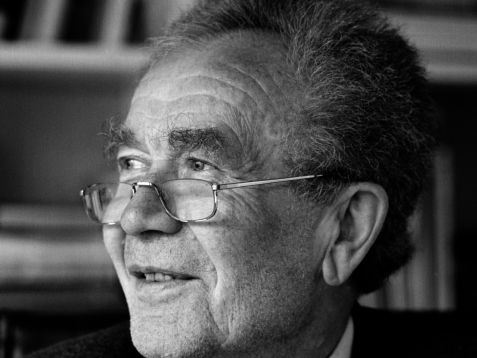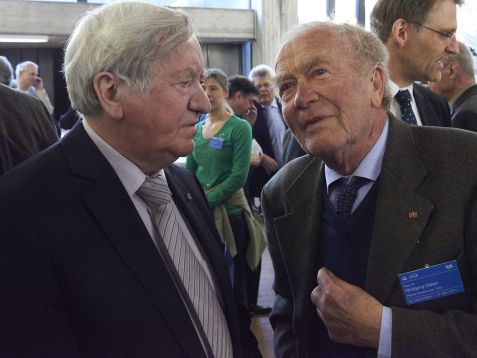MLZ is a cooperation between:
 > Technische Universität München
> Technische Universität München > Helmholtz-Zentrum Hereon
> Helmholtz-Zentrum Hereon
 > Forschungszentrum Jülich
> Forschungszentrum Jülich
MLZ is a member of:
 > LENS
> LENS > ERF-AISBL
> ERF-AISBL
MLZ on social media:

MLZ (eng)
Lichtenbergstr.1
85748 Garching
10.02.2023
Founding father of FRM II deceased: In mourning for Wolfgang Gläser
He was the successor of Heinz Maier-Leibnitz and contributed significantly to the fact that the most modern neutron source in the world is located in Garching. Recently, Prof. Dr. Wolfgang Gläser has passed away at the age of 89.

Prof. Dr. Wolfgang Gläser was Scientific Director from 1974 to 1999 at the atomic egg and is founding father of the FRM II. © TUM
Wolfgang Gläser, born on July 6, 1933, studied physics in Jena until 1958. After obtaining his doctorate and post-doctorate at the University of Karlsruhe, he became head of the Institute for Applied Nuclear Physics at the Karlsruhe Nuclear Research Center in 1970. With his work from that time, he contributed early to the French-German collaboration at the research neutron source in Grenoble. His scientific activities and his great experience in the use of the Karlsruhe research reactor earned him a call to the Technical University of Munich (TUM), where he took over the chair of Experimental Physics E 21 from Prof. Heinz Maier-Leibnitz at the Physics Department on December 1, 1974.
Plans for building a new research reactor
Like his predecessor, Wolfgang Gläser also became the scientific director at the research reactor in Garching, known as the Atomic Egg. His physical interests were the atomic dynamics of simple liquids and the lattice dynamics of superconductors. In addition, he was involved in the further development of neutron physics methods and the investigation of radiation damage in materials. As a member of national and international expert committees, Gläser and his colleagues were already involved in studies for new neutron sources at the end of the 1970s. Initial plans for modernizing the Atomic Egg in Garching turned into plans for a new building, which came closer to realization in 1989 with a recommendation from the Science Council. “From the very beginning, he had the desire to improve the Atomic Egg,” says his longtime colleague and FRM II project manager Prof. Dr. Klaus Böning.

Prof. Dr. Wolfgang Gläser (r.) in conversation with former Bavarian Science Minister Hans Zehetmair at the celebration of the tenth anniversary of FRM II in 2014. © Wenzel Schürmann, TUM
Great foresight in large-scale project FRM II
From 1977 to 1979, Wolfgang Gläser was dean of the Faculty of Physics. From 1986 to 1989, he was the director of the Institut Laue-Langevin in Grenoble. Prof. Gläser set the scientific course for the FRM II, of which he was founding director until 1999. “Mr. Gläser planted the seeds for what we are harvesting today: the highest brilliance of neutron beams for basic research, medical and industrial applications,” says Prof. Dr. Winfried Petry, Gläser’s successor in the office of Scientific Director of the Research Neutron Source Heinz Maier-Leibnitz (FRM II). In addition, acting Scientific Director of the FRM II and at the Heinz Maier-Leibnitz Zentrum, Prof. Dr. Peter Müller-Buschbaum, adds, “We are grateful to our founding father for his great foresight in the scientific and political implementation of this large-scale project FRM II and will honor his memory.”
Federal Cross of Merit for credibility in research policy
The last ten years of Gläser’s work are characterized on the one hand by the optimization and implementation of the plans for the FRM II, and on the other hand by constructive dispute with the critics of this project. Prof. Gläser retired in 2001. In 1996, the physicist received the Order of Merit of the Federal Republic of Germany, 1st class, for his scientific achievements and for conveying credibility in research policy. Wolfgang Gläser passed away on February 4, 2023 and is buried in Vaterstetten.
MLZ is a cooperation between:
 > Technische Universität München
> Technische Universität München > Helmholtz-Zentrum Hereon
> Helmholtz-Zentrum Hereon
 > Forschungszentrum Jülich
> Forschungszentrum Jülich
MLZ is a member of:
 > LENS
> LENS > ERF-AISBL
> ERF-AISBL
MLZ on social media:


